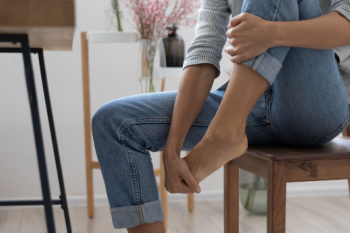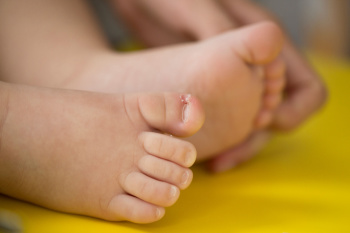Blog
Items filtered by date: May 2024
Dealing With Achilles Tendon Ruptures

Diagnosing Achilles tendon ruptures involves a combination of clinical evaluation and imaging tests. The Achilles tendon, the largest tendon in the body, connects the calf muscles to the heel bone. A rupture occurs when this tendon tears, often due to sudden or forceful movements during sports or activities that place excessive stress on the tendon. Symptoms of an Achilles tendon rupture typically include a sudden, sharp pain in the back of the ankle or calf, accompanied by swelling and difficulty walking or standing on tiptoe. While this injury can happen to anyone, factors such as age, sports participation, and pre-existing foot problems like flat feet or tendonitis may increase the risk. Treatment options include conservative measures like immobilization to more advanced options, like surgical repair for severe cases. If you have injured your Achilles tendon, it is strongly suggested that you schedule an appointment with a podiatrist for an accurate diagnosis and treatment plan.
Achilles tendon injuries need immediate attention to avoid future complications. If you have any concerns, contact one of our podiatrists of Romeo Foot & Ankle Clinic. Our doctors can provide the care you need to keep you pain-free and on your feet.
What Is the Achilles Tendon?
The Achilles tendon is a tendon that connects the lower leg muscles and calf to the heel of the foot. It is the strongest tendon in the human body and is essential for making movement possible. Because this tendon is such an integral part of the body, any injuries to it can create immense difficulties and should immediately be presented to a doctor.
What Are the Symptoms of an Achilles Tendon Injury?
There are various types of injuries that can affect the Achilles tendon. The two most common injuries are Achilles tendinitis and ruptures of the tendon.
Achilles Tendinitis Symptoms
- Inflammation
- Dull to severe pain
- Increased blood flow to the tendon
- Thickening of the tendon
Rupture Symptoms
- Extreme pain and swelling in the foot
- Total immobility
Treatment and Prevention
Achilles tendon injuries are diagnosed by a thorough physical evaluation, which can include an MRI. Treatment involves rest, physical therapy, and in some cases, surgery. However, various preventative measures can be taken to avoid these injuries, such as:
- Thorough stretching of the tendon before and after exercise
- Strengthening exercises like calf raises, squats, leg curls, leg extensions, leg raises, lunges, and leg presses
If you have any questions please feel free to contact our offices located in Washington and Shelby Townships, MI . We offer the newest diagnostic tools and technology to treat your foot and ankle needs.
How Serious Is a Stubbed Toe?

A stubbed toe might seem like a minor inconvenience, but the pain it inflicts can be surprisingly intense. Stubbing your toe ranges from simple bruises to fractures, each with its own level of severity and potential complications. When you stub your toe, you are essentially subjecting it to sudden trauma. Common scenarios include accidentally ramming your toe into furniture or catching it on objects. Despite its seemingly innocuous nature, the impact can lead to a variety of injuries. Determining the extent of a stubbed toe injury is not always straightforward. Symptoms like intense pain, swelling, and difficulty while walking can accompany anything from a minor bruise to a fracture. The lack of immediate clarity underscores the importance of seeking professional help, particularly from a podiatrist. Bone bruises, strains, sprains, and toenail injuries are common consequences of stubbing a toe, each requiring different forms of treatment and management. Severe pain, swelling, visible deformities, or signs of infection warrant immediate attention. If you are suffering from toe pain, it is suggested that you make an immediate appointment with a podiatrist.
Toe pain can disrupt your daily activities. If you have any concerns, contact one of our podiatrists of Romeo Foot & Ankle Clinic. Our doctors can provide the care you need to keep you pain-free and on your feet.
What Causes Toe Pain?
Most severe toe pain is caused due to a sports injury, trauma from dropping something heavy on the toe, or bumping into something rigid. Other problems can develop over time for various reasons.
Toe pain can be caused by one or more ailments. The most common include:
- Trauma
- Sports injury
- Wearing shoes that are too tight
- Arthritis
- Gout
- Corns and calluses
- Hammertoe
- Bunions
- Blisters
- Ingrown toenails
- Sprains
- Fractures (broken bones)
- Dislocations
When to See a Podiatrist
- Severe pain
- Persistent pain that lasts more than a week
- Signs of infection
- Continued swelling
- Pain that prevents walking
Diagnosis
In many cases the cause of toe pain is obvious, but in others, a podiatrist may want to use more advanced methods to determine the problem. These can range from simple visual inspections and sensation tests to X-rays and MRI scans. Prior medical history, family medical history, and any recent physical traumatic events will all be taken into consideration for a proper diagnosis.
Treatment
Treatments for toe pain and injuries vary and may include shoe inserts, padding, taping, medicines, injections, and in some cases, surgery. If you believe that you have broken a toe, please see a podiatrist as soon as possible.
If you have any questions please feel free to contact our offices located in Washington and Shelby Townships, MI . We offer the newest diagnostic tools and technology to treat your foot and ankle needs.
Ingrown Toenails in Children
 Ingrown toenails occur when the nail grows into the skin instead of over it, often the result of improper nail trimming, tight footwear, or injury. Ingrown toenails are common in children, as well as adults. The condition can cause pain, redness, and swelling around the child’s toe. If not treated properly, it can lead to infection. Especially for children, treatment typically begins conservatively, using methods such as soaking the affected foot in warm, soapy water to soften the nail and relieve pain. A podiatrist, or foot doctor, may try lifting the edge of the ingrown nail and placing a small amount of cotton underneath it to help guide the nail to grow above the skin. I is important for children to wear properly fitting shoes and to have their toenails trimmed straight across instead of rounded. This can help prevent the recurrence of ingrown toenails. If conservative treatments fail or if the ingrown toenail recurs frequently, a podiatrist may perform a minor procedure to remove part of the nail. They may treat the nail bed to prevent further issues, if necessary. This approach helps alleviate discomfort and prevent potential complications. If your child is suffering with an ingrown toenail, it is suggested you schedule an appointment with a podiatrist for prompt treatment.
Ingrown toenails occur when the nail grows into the skin instead of over it, often the result of improper nail trimming, tight footwear, or injury. Ingrown toenails are common in children, as well as adults. The condition can cause pain, redness, and swelling around the child’s toe. If not treated properly, it can lead to infection. Especially for children, treatment typically begins conservatively, using methods such as soaking the affected foot in warm, soapy water to soften the nail and relieve pain. A podiatrist, or foot doctor, may try lifting the edge of the ingrown nail and placing a small amount of cotton underneath it to help guide the nail to grow above the skin. I is important for children to wear properly fitting shoes and to have their toenails trimmed straight across instead of rounded. This can help prevent the recurrence of ingrown toenails. If conservative treatments fail or if the ingrown toenail recurs frequently, a podiatrist may perform a minor procedure to remove part of the nail. They may treat the nail bed to prevent further issues, if necessary. This approach helps alleviate discomfort and prevent potential complications. If your child is suffering with an ingrown toenail, it is suggested you schedule an appointment with a podiatrist for prompt treatment.
Ingrown toenails can become painful if they are not treated properly. For more information about ingrown toenails, contact one of our podiatrists of Romeo Foot & Ankle Clinic. Our doctors can provide the care you need to keep you pain-free and on your feet.
Ingrown Toenails
Ingrown toenails occur when a toenail grows sideways into the bed of the nail, causing pain, swelling, and possibly infection.
Causes
- Bacterial infections
- Improper nail cutting such as cutting it too short or not straight across
- Trauma to the toe, such as stubbing, which causes the nail to grow back irregularly
- Ill-fitting shoes that bunch the toes too close together
- Genetic predisposition
Prevention
Because ingrown toenails are not something found outside of shoe-wearing cultures, going barefoot as often as possible will decrease the likeliness of developing ingrown toenails. Wearing proper fitting shoes and using proper cutting techniques will also help decrease your risk of developing ingrown toenails.
Treatment
Ingrown toenails are a very treatable foot condition. In minor cases, soaking the affected area in salt or antibacterial soaps will not only help with the ingrown nail itself, but also help prevent any infections from occurring. In more severe cases, surgery is an option. In either case, speaking to your podiatrist about this condition will help you get a better understanding of specific treatment options that are right for you.
If you have any questions please feel free to contact our offices located in Washington and Shelby Townships, MI . We offer the newest diagnostic and treatment technologies for all your foot and ankle needs.
Treatment for Foot Corns
 Corns are thickened skin areas that form to protect the skin against friction and pressure, and often occur on the feet. A podiatrist, or foot doctor, may recommend changing to footwear that fits better and doesn't squeeze or rub against the foot. Additionally, they might recommend padding or cushions to protect the corn and reduce pressure when walking. In more persistent cases, a podiatrist may carefully trim the thickened skin using a scalpel, a procedure that should never be attempted at home because of the risk of infection. Custom foot orthotics may also be suggested to correct any foot abnormalities that contribute to corn formation. Along with proper foot hygiene, these treatments can effectively manage and prevent the discomfort associated with corns. If you are struggling with corns on the feet, it is suggested that you consult a podiatrist for help.
Corns are thickened skin areas that form to protect the skin against friction and pressure, and often occur on the feet. A podiatrist, or foot doctor, may recommend changing to footwear that fits better and doesn't squeeze or rub against the foot. Additionally, they might recommend padding or cushions to protect the corn and reduce pressure when walking. In more persistent cases, a podiatrist may carefully trim the thickened skin using a scalpel, a procedure that should never be attempted at home because of the risk of infection. Custom foot orthotics may also be suggested to correct any foot abnormalities that contribute to corn formation. Along with proper foot hygiene, these treatments can effectively manage and prevent the discomfort associated with corns. If you are struggling with corns on the feet, it is suggested that you consult a podiatrist for help.
Corns can make walking very painful and should be treated immediately. If you have questions regarding your feet and ankles, contact one of our podiatrists of Romeo Foot & Ankle Clinic. Our doctors will treat your foot and ankle needs.
Corns: What Are They? And How Do You Get Rid of Them?
Corns are thickened areas on the skin that can become painful. They are caused by excessive pressure and friction on the skin. Corns press into the deeper layers of the skin and are usually round in shape.
Ways to Prevent Corns
There are many ways to get rid of painful corns such as:
- Wearing properly fitting shoes that have been measured by a professional
- Wearing shoes that are not sharply pointed or have high heels
- Wearing only shoes that offer support
Treating Corns
Although most corns slowly disappear when the friction or pressure stops, this isn’t always the case. Consult with your podiatrist to determine the best treatment option for your case of corns.
If you have any questions please feel free to contact our offices located in Washington and Shelby Townships, MI . We offer the newest diagnostic and treatment technologies for all your foot and ankle needs.
Wounds That Don't Heal Need to Be Checked
Blog Archives
- July 2024
- June 2024
- May 2024
- April 2024
- March 2024
- February 2024
- January 2024
- December 2023
- November 2023
- October 2023
- September 2023
- August 2023
- July 2023
- June 2023
- May 2023
- April 2023
- March 2023
- February 2023
- January 2023
- December 2022
- November 2022
- October 2022
- September 2022
- August 2022
- July 2022
- June 2022
- May 2022
- April 2022
- March 2022
- February 2022
- January 2022
- December 2021
- November 2021
- October 2021
- September 2021
- August 2021
- July 2021
- June 2021
- May 2021
- April 2021
- March 2021
- February 2021
- January 2021
- December 2020
- November 2020
- October 2020
- September 2020
- August 2020
- July 2020
- June 2020
- May 2020
- April 2020
- March 2020
- February 2020
- January 2020
- December 2019
- November 2019
- October 2019
- September 2019
- August 2019
- July 2019
- June 2019
- May 2019
- April 2019
- March 2019
- February 2019
- January 2019
- December 2018
- November 2018
- October 2018
- September 2018
- August 2018
- July 2018
- June 2018
- May 2018

